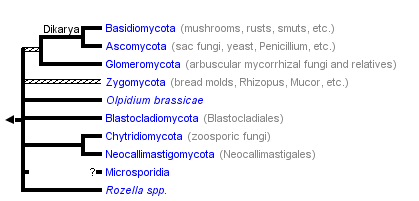
Mostly, fungi are classified based on the characteristics of their sexual reproductive structures.
Seven phyla are proposed:
Microsporidia:
Unicellular parasites that are also known as endobiotic fungi which mean they live within the tissue of another species.
Chytridiomycota
Also known as Chytrids this type of fungi produce zoospores that can move using a flagellum. They thrive through aqueous phases.
.
Blastocladiomycota
They are saprotrophs, feeding on decomposing organic matter, and they are parasites of all eukaryotic groups.
Neocallimastigomycota
They are anaerobic organisms, that inhabit the digestive system of larger herbivorous mammals and possibly in other terrestrial and aquatic environments.
Glomeromycota
They form arbuscular mycorrhizae, a form of symbiosis wherein fungal hyphae invade plant root cells and both species benefit from the resulting increased supply of nutrients. All known
Glomeromycota species reproduce asexually.
Ascomycota
Also known as ascomycetes, constitute the largest taxonomic group within the Fungi. They form meiotic spores called ascospores, which are enclosed in a special saclike structure called an ascus. Members of this phylum ar morels, a few mushrooms, truffles and singlecelled yeasts among many more.
Basidiomycota
Another name for this phylum is basidiomycetes. Tehy produce meiospores called basidiospores on clublike stalks called basidia. Most common mushrooms belong to this group, as well as rust and smut fungi, which are major pathogens of grains.







No comments:
Post a Comment